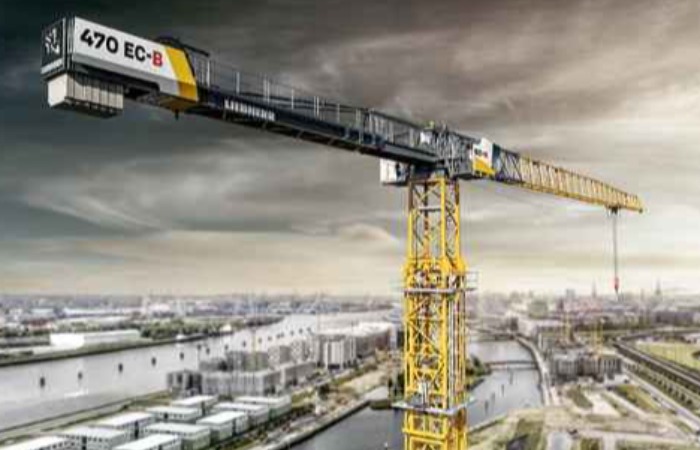
Liebherr presents 470 EC-B flat-top crane
The flagship crane with intelligent assistance systems offers a jib length of 80 metres. This reach can be increased to 83 metres by means of a jib extension, thereby breaking new ground in the competitive market. At a jib length of 80 metres, the 16-tonne version of the 470 EC-B has a jib head load capacity of up to 3,200 kilograms; the 20-tonne version impresses with a jib head load capacity of up to 3,000 kilograms. The jib can be divided into two-and-a-half metre sections so that it can be perfectly adapted to meet a variety of operational requirements. The 470 EC-B went on sale in January of this year.
Optimised for transport and assembly
The focus during development wasn’t only on performance but also on assembly and transport. As a result, the jib and counter-jib can be attached to the slewing platform easily, conveniently and safely. Liebherr’s proven quick assembly connections make it all possible. Only five trucks are needed to transport the slewing part with jib, including counter-ballast, to the construction site. This saves time and money, and also helps reduce emissions.
The 470 EC-B features a connection for both 24 HC 420 and 24 HC 630 tower systems. The 24 HC tower system is a perfect match for large cranes with high lifting capacities. Its compact dimensions allow individual elements to be moved cost-efficiently from A to B.
The 470 EC-B has been optimised for the 24 HC 420 tower system; together they are the most cost-effective combination for freestanding hook heights of up to 67.8 metres. The maximum freestanding hook height of up to 96 metres is achieved with the 24 HC 630 system.
Excellent overview of site and parameters for the crane operator
The top-slewing crane is available with one of three versions of the sophisticated LiCAB crane operator’s cab: LiCAB Basic, LiCAB Air or LiCAB AirPlus. All three offer a floor space of more than two square metres, an unrestricted view for precision lifting and an ergonomic control stand. These and other comfort features enable the crane operator to stay fully focused on the job at hand. Thanks to the cab’s extensive field of vision, the crane operator has a clear view of the site and the load to be lifted, which contributes to the safety of both operator and machine.
Also included in the cab is the newly developed twelve-inch display screen with intuitive operability. The Tower Crane Operating System (TC-OS) provides crane operators and assembly engineers with specific menus, an extensive choice of languages and user-friendly units of measurement. The intention is that every user should be able to find the parameters relevant to their work without difficulty. Users navigate their way through the streamlined menu structure via touchscreen. To maintain an overview during crane operation or scaling, display masks can be combined in various ways. The exceptional usability of the TC-OS means that training and familiarisation times are reduced.
LED advertising space lighting for a powerful promotional impact
LED advertising panel lighting can be configured to ensure a substantial long-distance effect and visibility, particularly at the onset of twilight and at night. With a total area of 8.6 square metres, the robust lighting is capable of delivering a powerful and effective promotional impact. The panels don’t have to be mounted separately during assembly and can remain in place on the counter-jib end section during transport. Signage is easily applied.
Flat-Top cranes equipped for a variety of applications
As they don’t have a tower head structure, several EC-B series Flat-Top cranes are able to work together safely on the same site, even in tight conditions. Transport, assembly, handling capacity and safety: EC-B cranes are specifically designed to meet the requirements of modern construction sites. They cover a wide performance spectrum, ranging from small city to large handling cranes. The new 470 EC-B completes the top end of Liebherr’s successful series, with the crane reflecting the construction industry’s trend towards ever heavier components.


 +91-22-24193000
+91-22-24193000 Subscriber@ASAPPinfoGlobal.com
Subscriber@ASAPPinfoGlobal.com